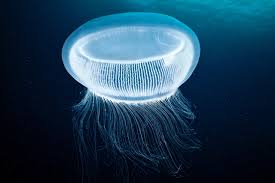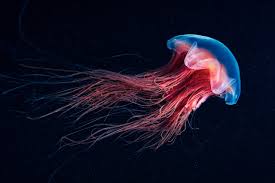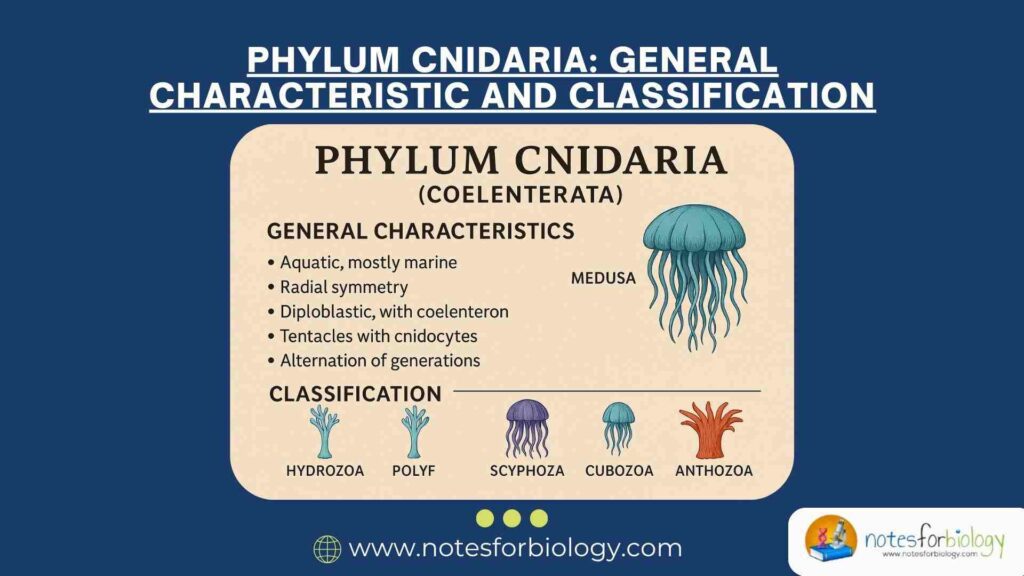Phylum Cnidaria, also historically known as Coelenterata, includes a fascinating group of aquatic invertebrates primarily found in marine environments, though some inhabit freshwater bodies. These organisms are characterized by their simple tissue organization, radial symmetry, and a unique mechanism for capturing prey through specialized stinging cells. Coelenterons exhibit diverse body forms, from free-swimming jellyfish to sessile sea anemones and colonial coral structures that contribute to the formation of reefs.
Phylum Cnidaria refers to a group of diploblastic, radially symmetrical, acoelomate animals distinguished by the presence of specialized cells known as cnidocytes. These stinging cells contain organelles called nematocysts that assist in prey capture and defense. Cnidarians possess a simple body plan with a single internal cavity, the coelenteron, serving both digestive and circulatory functions.
Summary of Phylum Cnidaria
- Cnidarians are diploblastic, radially symmetrical aquatic animals with stinging cells (cnidocytes).
- They have two body forms: polyp (sessile) and medusa (free-swimming).
- The phylum includes jellyfish, corals, sea anemones, and Hydra.
Table of Contents
General Characteristics of Phylum Cnidaria
Body Symmetry
Members of Phylum Cnidaria exhibit radial symmetry. In this type of symmetry, the body can be divided into similar halves along multiple planes passing through the central axis. This arrangement allows these organisms to interact with their environment from all directions, which is especially advantageous for sessile and free-floating aquatic animals.
Tissue Organization
Cnidarians are diploblastic, meaning their body wall is composed of two primary germ layers: the outer ectoderm and the inner endoderm. Between these layers lies a gelatinous, non-cellular layer called mesoglea. This tissue arrangement represents an early stage of multicellular complexity in the animal kingdom.
Body Wall Structure
The outer layer, known as the epidermis, is derived from the ectoderm and contains sensory cells, muscle cells, and specialized stinging cells or cnidocytes. The inner layer, the gastrodermis, is derived from the endoderm and lines the gastrovascular cavity, where digestion occurs. Between these two layers, the mesoglea acts as a supportive, elastic, and buoyant material.
Cnidocytes and Nematocysts
A defining feature of this phylum is the presence of cnidocytes, which are specialized cells capable of producing and discharging stinging structures called nematocysts. These organelles contain a coiled, thread-like tube that, upon stimulation, everts rapidly to inject venom into prey or predators, aiding in capture, defense, and adhesion.
Gastrovascular Cavity
The internal cavity of cnidarians, known as the coelenteron or gastrovascular cavity, serves multiple roles including digestion, distribution of nutrients, and excretion. It has a single opening that functions both as the mouth and the anus, a characteristic typical of lower invertebrates.
Body Forms
Cnidarians display polymorphism in the form of two main body plans: the sessile polyp and the free-swimming medusa. The polyp is a tubular, cylindrical structure with a mouth surrounded by tentacles at one end and is attached to a substrate at the other. The medusa is bell-shaped or umbrella-shaped, adapted for free-floating existence, with tentacles hanging from its margins.
Mode of Digestion
Digestion in cnidarians is both extracellular and intracellular. The initial breakdown of prey occurs within the gastrovascular cavity through the action of enzymes, followed by intracellular digestion within the cells of the gastrodermis.
Nervous System
Cnidarians possess a simple, decentralized nerve net, which is spread throughout the body, especially concentrated around the tentacles and the mouth region. This primitive nervous system allows for basic responses to stimuli such as touch, light, and chemical signals.
Reproduction
Reproduction in cnidarians can be both asexual and sexual. Asexual reproduction commonly occurs through budding in polyps, where new individuals grow directly from the parent organism. Sexual reproduction involves the formation of gametes, with fertilization leading to the formation of a free-swimming planula larva, which later settles to form a new polyp.
Habitat
Most Coelenterons are exclusively marine, with a few freshwater representatives such as Hydra. They are found in a wide range of aquatic habitats, from shallow coastal waters to the deep sea. Some, like corals, contribute to reef-building and form complex ecosystems.
Classification of Phylum Cnidaria
Phylum Cnidaria is broadly classified into four major classes based on their morphology, life cycle, and the presence or absence of specific structural features.
Class Hydrozoa

The class Hydrozoa includes cnidarians that may exist either in solitary or colonial forms. These organisms typically exhibit an alternation of generations between polyp and medusa stages, though in some cases one of these forms may be reduced or absent. The polyp is usually dominant, and reproduction occurs both sexually and asexually.
Members of Hydrozoa often have a thin mesoglea and possess cnidocytes primarily in the epidermis. Examples of this class include Hydra, Obelia, Physalia (Portuguese man o’ war), and Velella.
Class Scyphozoa

Scyphozoa is a class that predominantly includes the true jellyfish. In this class, the medusa stage is dominant and represents the main body form, while the polyp stage is either reduced or exists only in early life stages. Scyphozoans possess a thick, gelatinous mesoglea, contributing to their buoyancy.
They display a highly developed gastrovascular cavity with radial and circular canals for nutrient distribution. Scyphozoans are entirely marine and are known for their often large, colorful, and translucent medusae. Notable examples include Aurelia (moon jelly) and Cyanea capillata (lion’s mane jellyfish).
Class Cubozoa

Cubozoa, commonly referred to as box jellyfish, includes species with a cube-shaped, box-like medusa. The medusa is the dominant life form in this class, and the polyp stage is minimal or absent. Cubozoans are distinguished by their complex eyes, located within sensory structures called rhopalia, enabling them to detect light and navigate their environment effectively.
These organisms are noted for their potent venom, which in some species, like Chironex fleckeri (sea wasp), can be fatal to humans. Cubozoans inhabit tropical and subtropical marine waters and are agile, fast swimmers compared to other cnidarians.
Class Anthozoa
Anthozoa is a class characterized by the exclusive presence of the polyp form, with no medusa stage in their life cycle. Members of this class may be solitary or colonial and are often involved in reef-building processes. Anthozoans possess a well-developed pharynx and gastrovascular cavity partitioned by septa, increasing the surface area for digestion.
They reproduce both sexually and asexually and include a vast array of marine organisms such as sea anemones, stony corals, soft corals, and sea pens. Important examples include Adamsia, Fungia, Gorgonia, and Madrepora.
Symmetry in Cnidarians
Cnidarians show radial symmetry, where their body parts are arranged around a central axis. This allows them to interact with their surroundings equally from all directions.
Advantages of Radial Symmetry in Cnidarians
Equal Sensory Reception from All Directions
Radial symmetry allows cnidarians to receive stimuli like touch, light, or chemicals from every side of their body. This is useful for organisms like jellyfish and sea anemones that remain stationary or drift in water, as they can detect changes in their environment from any angle.
Efficient Food Capture
Since tentacles and sensory structures are arranged evenly around the mouth, cnidarians can capture prey approaching from any direction without needing to turn their body. This increases their chances of feeding successfully in open water or when attached to a surface.
Simple Body Organization
Radial symmetry supports a simple and effective body plan with a central mouth and surrounding tentacles. It allows a nerve net and muscles to be evenly distributed, making coordination of movements and feeding easier without a complex nervous system.
Adaptation to Sessile and Drifting Lifestyles
Radial symmetry is especially suited for animals that are either fixed in place (like sea anemones and corals) or float freely (like jellyfish). It ensures they remain equally functional no matter how water currents move them.
Types of Symmetry in Cnidarians
Although radial symmetry is the main type found in cnidarians, there are some variations:
Radial Symmetry
This is the basic form where body parts are arranged symmetrically around a central axis. Any longitudinal plane passing through the axis divides the animal into similar halves. It is seen in most cnidarians, like hydras, sea anemones, and jellyfish.
Tetramerous Symmetry
A special form of radial symmetry where body parts are arranged in multiples of four (like 4, 8, or 16). This is common in jellyfish (class Scyphozoa), where structures such as tentacles, gonads, and canals are grouped in fours.
Biradial Symmetry
A combination of radial and bilateral symmetry. In this, the body can be divided into identical halves along two planes only. It occurs when paired structures make two planes of symmetry possible instead of infinite planes. It is rare in cnidarians but seen in some anthozoans.
Movement of Cnidarians
Cnidarians move using simple muscle fibers and a nerve net. There are two main body forms: polyp and medusa, and each moves differently.
Polyp Movement
Polyps, like hydras and sea anemones, are mostly sessile (attached to surfaces) but can perform limited movements. They bend, contract, and somersault using muscle contractions and a water-filled gastrovascular cavity acting as a hydrostatic skeleton. Some can glide slowly on their base or detach and drift.
Medusa Movement
Medusae, like jellyfish, are free-swimming. They move by pulsating their bell-shaped body, expelling water to propel themselves forward in a type of jet propulsion. Circular muscle bands around the bell contract rhythmically, while the mesoglea’s elasticity helps restore shape after each contraction.
Nerve Net Role
Both forms have a simple, decentralized nerve net that coordinates muscle actions and responds to environmental stimuli. In medusae, special sense organs called rhopalia help with balance and detecting light.
Conclusion
Phylum Cnidaria represents one of the earliest diverging animal groups with true tissue organization. Distinguished by their radial symmetry, diploblastic organization, presence of cnidocytes, and polymorphic life forms, cnidarians occupy a crucial position in marine ecosystems. Their ability to alternate between polyp and medusa forms, combined with both asexual and sexual modes of reproduction, reflects a remarkable adaptability.
The classification of cnidarians into four principal classes : Hydrozoa, Scyphozoa, Cubozoa, and Anthozoa which is based on distinct morphological and developmental features. From the delicate Hydra to the majestic Aurelia and the vital reef-forming corals, cnidarians contribute significantly to biodiversity, ecological stability, and the evolutionary history of multicellular animals.
Frequently Asked Questions (FAQ)
Are Cnidaria acoelomate?
Yes, phylum Cnidaria are acoelomate because they lack a true body cavity. Their body has two layers (diploblastic) with a jelly-like mesoglea in between.
Why is Coelenterata also called Cnidaria?
The old name Coelenterata referred to their hollow body cavity. Now they’re called Cnidaria because of their unique stinging cells (cnidocytes), which is their main identifying feature.
How do Cnidaria reproduce?
Cnidarians reproduce both asexually by budding (in polyps) and sexually by gametes (in medusae or polyps), producing a planula larva after fertilization.
Related Contents
Bacteroides: Classification, virulence factors and biochemical tests




